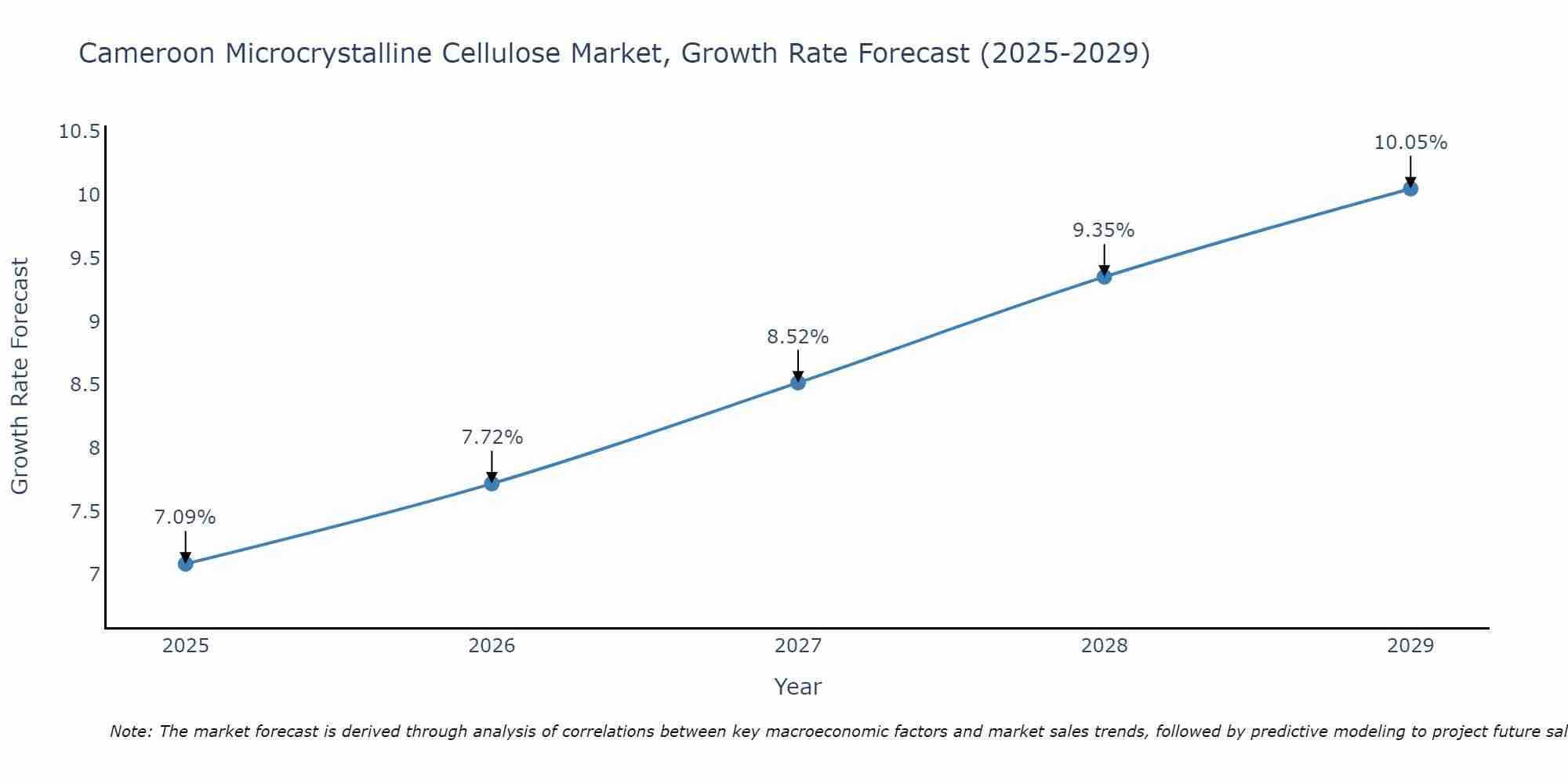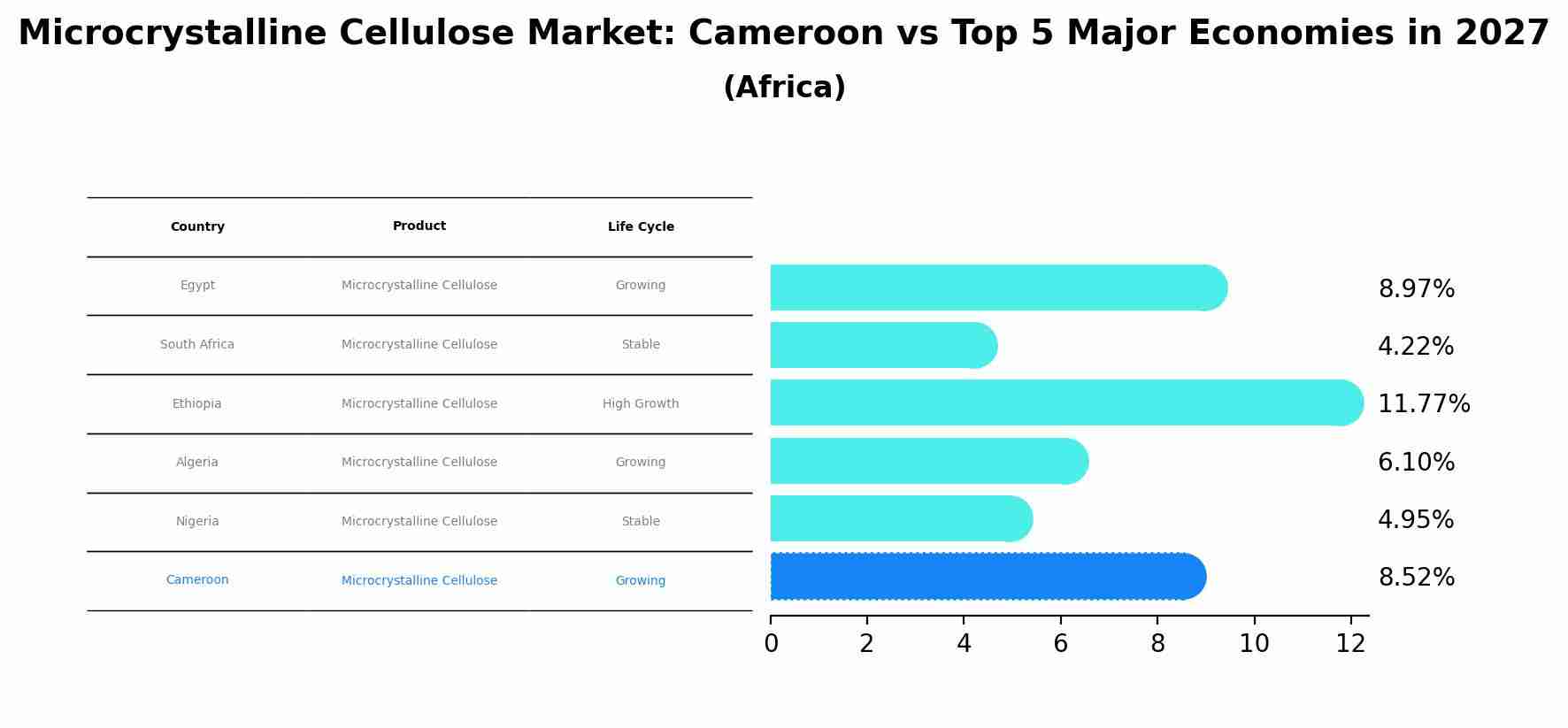Cameroon Microcrystalline Cellulose Market (2025-2031) | Value, Industry, Segmentation, Forecast, Share, Size, Companies, Outlook, Revenue, Growth, Analysis & Trends
| Product Code: ETC4756626 | Publication Date: Nov 2023 | Updated Date: Sep 2025 | Product Type: Market Research Report | |
| Publisher: 6Wresearch | Author: Sachin Kumar Rai | No. of Pages: 60 | No. of Figures: 30 | No. of Tables: 5 |
Cameroon Microcrystalline Cellulose Market Size Growth Rate
The Cameroon Microcrystalline Cellulose Market is poised for steady growth rate improvements from 2025 to 2029. The growth rate starts at 7.09% in 2025 and reaches 10.05% by 2029.

Microcrystalline Cellulose Market: Cameroon vs Top 5 Major Economies in 2027 (Africa)
The Microcrystalline Cellulose market in Cameroon is projected to grow at a growing growth rate of 8.52% by 2027, highlighting the country's increasing focus on advanced technologies within the Africa region, where Egypt holds the dominant position, followed closely by South Africa, Ethiopia, Algeria and Nigeria, shaping overall regional demand.

Cameroon Microcrystalline Cellulose Market Overview
The microcrystalline cellulose market in Cameroon is developing, driven by the demand for excipients in the pharmaceutical and food industries. Microcrystalline cellulose is a widely used excipient in tablet formulations, providing excellent compressibility and stability. It is also used as a thickener and stabilizer in food products. The market growth is supported by the expanding pharmaceutical and food processing sectors in Cameroon, as well as the increasing demand for high-quality ingredients.
Drivers of the market
The Microcrystalline Cellulose market in Cameroon is developing due to its wide range of applications in the pharmaceutical, food, and cosmetic industries. Microcrystalline cellulose is used as a filler, binder, and stabilizer, making it a versatile ingredient in product formulations. The market is driven by the rising demand for processed food and pharmaceutical products, along with advancements in cellulose extraction and processing technologies.
Challenges of the market
The Microcrystalline Cellulose Market in Cameroon faces several challenges, primarily due to high costs associated with importing quality cellulose and limited local production capabilities. The market also suffers from a lack of awareness and understanding among potential users about the benefits of microcrystalline cellulose in various applications, affecting demand. Inadequate technical support and infrastructure for handling and processing cellulose further constrain market growth. Moreover, regulatory challenges and the absence of supportive policies for the chemical and pharmaceutical industries present significant obstacles.
Government Policy of the market
The government policy towards the Microcrystalline Cellulose Market in Cameroon is geared towards supporting the pharmaceutical and food industries. The government encourages local production of microcrystalline cellulose through tax incentives and subsidies for research and development. Policies are also in place to promote the use of cellulose in various applications, such as drug formulation and food additives. Challenges include high production costs and competition from international suppliers.
Key Highlights of the Report:
- Cameroon Microcrystalline Cellulose Market Outlook
- Market Size of Cameroon Microcrystalline Cellulose Market, 2024
- Forecast of Cameroon Microcrystalline Cellulose Market, 2031
- Historical Data and Forecast of Cameroon Microcrystalline Cellulose Revenues & Volume for the Period 2021-2031
- Cameroon Microcrystalline Cellulose Market Trend Evolution
- Cameroon Microcrystalline Cellulose Market Drivers and Challenges
- Cameroon Microcrystalline Cellulose Price Trends
- Cameroon Microcrystalline Cellulose Porter`s Five Forces
- Cameroon Microcrystalline Cellulose Industry Life Cycle
- Historical Data and Forecast of Cameroon Microcrystalline Cellulose Market Revenues & Volume By Source Type for the Period 2021-2031
- Historical Data and Forecast of Cameroon Microcrystalline Cellulose Market Revenues & Volume By Non-Wood Based for the Period 2021-2031
- Historical Data and Forecast of Cameroon Microcrystalline Cellulose Market Revenues & Volume By Wood-Based for the Period 2021-2031
- Historical Data and Forecast of Cameroon Microcrystalline Cellulose Market Revenues & Volume By End-use for the Period 2021-2031
- Historical Data and Forecast of Cameroon Microcrystalline Cellulose Market Revenues & Volume By Binder/Diluent for the Period 2021-2031
- Historical Data and Forecast of Cameroon Microcrystalline Cellulose Market Revenues & Volume By Bulking agent for the Period 2021-2031
- Historical Data and Forecast of Cameroon Microcrystalline Cellulose Market Revenues & Volume By Emulsifiers for the Period 2021-2031
- Historical Data and Forecast of Cameroon Microcrystalline Cellulose Market Revenues & Volume By Stabilizer for the Period 2021-2031
- Historical Data and Forecast of Cameroon Microcrystalline Cellulose Market Revenues & Volume By Anti-Caking Agent for the Period 2021-2031
- Historical Data and Forecast of Cameroon Microcrystalline Cellulose Market Revenues & Volume By Others for the Period 2021-2031
- Historical Data and Forecast of Cameroon Microcrystalline Cellulose Market Revenues & Volume By Application for the Period 2021-2031
- Historical Data and Forecast of Cameroon Microcrystalline Cellulose Market Revenues & Volume By Pharmaceutical for the Period 2021-2031
- Historical Data and Forecast of Cameroon Microcrystalline Cellulose Market Revenues & Volume By Food & Beverage for the Period 2021-2031
- Historical Data and Forecast of Cameroon Microcrystalline Cellulose Market Revenues & Volume By Cosmetics & Personal Care for the Period 2021-2031
- Historical Data and Forecast of Cameroon Microcrystalline Cellulose Market Revenues & Volume By Paints & coatings for the Period 2021-2031
- Historical Data and Forecast of Cameroon Microcrystalline Cellulose Market Revenues & Volume By Others for the Period 2021-2031
- Cameroon Microcrystalline Cellulose Import Export Trade Statistics
- Market Opportunity Assessment By Source Type
- Market Opportunity Assessment By End-use
- Market Opportunity Assessment By Application
- Cameroon Microcrystalline Cellulose Top Companies Market Share
- Cameroon Microcrystalline Cellulose Competitive Benchmarking By Technical and Operational Parameters
- Cameroon Microcrystalline Cellulose Company Profiles
- Cameroon Microcrystalline Cellulose Key Strategic Recommendations
Frequently Asked Questions About the Market Study (FAQs):
1 Executive Summary |
2 Introduction |
2.1 Key Highlights of the Report |
2.2 Report Description |
2.3 Market Scope & Segmentation |
2.4 Research Methodology |
2.5 Assumptions |
3 Cameroon Microcrystalline Cellulose Market Overview |
3.1 Cameroon Country Macro Economic Indicators |
3.2 Cameroon Microcrystalline Cellulose Market Revenues & Volume, 2021 & 2031F |
3.3 Cameroon Microcrystalline Cellulose Market - Industry Life Cycle |
3.4 Cameroon Microcrystalline Cellulose Market - Porter's Five Forces |
3.5 Cameroon Microcrystalline Cellulose Market Revenues & Volume Share, By Source Type, 2021 & 2031F |
3.6 Cameroon Microcrystalline Cellulose Market Revenues & Volume Share, By End-use, 2021 & 2031F |
3.7 Cameroon Microcrystalline Cellulose Market Revenues & Volume Share, By Application, 2021 & 2031F |
4 Cameroon Microcrystalline Cellulose Market Dynamics |
4.1 Impact Analysis |
4.2 Market Drivers |
4.2.1 Growing demand for pharmaceuticals and dietary supplements |
4.2.2 Increasing awareness about the benefits of microcrystalline cellulose in the food and beverage industry |
4.2.3 Rise in research and development activities in the healthcare sector in Cameroon |
4.3 Market Restraints |
4.3.1 Fluctuating raw material prices |
4.3.2 Stringent regulations and compliance requirements in the pharmaceutical industry |
4.3.3 Limited availability of skilled labor in the manufacturing sector |
5 Cameroon Microcrystalline Cellulose Market Trends |
6 Cameroon Microcrystalline Cellulose Market Segmentations |
6.1 Cameroon Microcrystalline Cellulose Market, By Source Type |
6.1.1 Overview and Analysis |
6.1.2 Cameroon Microcrystalline Cellulose Market Revenues & Volume, By Non-Wood Based, 2021-2031F |
6.1.3 Cameroon Microcrystalline Cellulose Market Revenues & Volume, By Wood-Based, 2021-2031F |
6.2 Cameroon Microcrystalline Cellulose Market, By End-use |
6.2.1 Overview and Analysis |
6.2.2 Cameroon Microcrystalline Cellulose Market Revenues & Volume, By Binder/Diluent, 2021-2031F |
6.2.3 Cameroon Microcrystalline Cellulose Market Revenues & Volume, By Bulking agent, 2021-2031F |
6.2.4 Cameroon Microcrystalline Cellulose Market Revenues & Volume, By Emulsifiers, 2021-2031F |
6.2.5 Cameroon Microcrystalline Cellulose Market Revenues & Volume, By Stabilizer, 2021-2031F |
6.2.6 Cameroon Microcrystalline Cellulose Market Revenues & Volume, By Anti-Caking Agent, 2021-2031F |
6.2.7 Cameroon Microcrystalline Cellulose Market Revenues & Volume, By Others, 2021-2031F |
6.3 Cameroon Microcrystalline Cellulose Market, By Application |
6.3.1 Overview and Analysis |
6.3.2 Cameroon Microcrystalline Cellulose Market Revenues & Volume, By Pharmaceutical, 2021-2031F |
6.3.3 Cameroon Microcrystalline Cellulose Market Revenues & Volume, By Food & Beverage, 2021-2031F |
6.3.4 Cameroon Microcrystalline Cellulose Market Revenues & Volume, By Cosmetics & Personal Care, 2021-2031F |
6.3.5 Cameroon Microcrystalline Cellulose Market Revenues & Volume, By Paints & coatings, 2021-2031F |
6.3.6 Cameroon Microcrystalline Cellulose Market Revenues & Volume, By Others, 2021-2031F |
7 Cameroon Microcrystalline Cellulose Market Import-Export Trade Statistics |
7.1 Cameroon Microcrystalline Cellulose Market Export to Major Countries |
7.2 Cameroon Microcrystalline Cellulose Market Imports from Major Countries |
8 Cameroon Microcrystalline Cellulose Market Key Performance Indicators |
8.1 Research and development expenditure in the pharmaceutical and food industries |
8.2 Number of patents filed for microcrystalline cellulose applications |
8.3 Adoption rate of microcrystalline cellulose in new product formulations |
9 Cameroon Microcrystalline Cellulose Market - Opportunity Assessment |
9.1 Cameroon Microcrystalline Cellulose Market Opportunity Assessment, By Source Type, 2021 & 2031F |
9.2 Cameroon Microcrystalline Cellulose Market Opportunity Assessment, By End-use, 2021 & 2031F |
9.3 Cameroon Microcrystalline Cellulose Market Opportunity Assessment, By Application, 2021 & 2031F |
10 Cameroon Microcrystalline Cellulose Market - Competitive Landscape |
10.1 Cameroon Microcrystalline Cellulose Market Revenue Share, By Companies, 2024 |
10.2 Cameroon Microcrystalline Cellulose Market Competitive Benchmarking, By Operating and Technical Parameters |
11 Company Profiles |
12 Recommendations | 13 Disclaimer |
- Single User License$ 1,995
- Department License$ 2,400
- Site License$ 3,120
- Global License$ 3,795
Search
Thought Leadership and Analyst Meet
Our Clients
Related Reports
- Germany Breakfast Food Market (2026-2032) | Industry, Share, Growth, Size, Companies, Value, Analysis, Revenue, Trends, Forecast & Outlook
- Australia Briquette Market (2025-2031) | Growth, Size, Revenue, Forecast, Analysis, Trends, Value, Share, Industry & Companies
- Vietnam System Integrator Market (2025-2031) | Size, Companies, Analysis, Industry, Value, Forecast, Growth, Trends, Revenue & Share
- ASEAN and Thailand Brain Health Supplements Market (2025-2031) | Strategy, Consumer Insights, Analysis, Investment Trends, Opportunities, Growth, Size, Share, Industry, Revenue, Segments, Value, Segmentation, Supply, Forecast, Restraints, Outlook, Competition, Drivers, Trends, Demand, Pricing Analysis, Competitive, Strategic Insights, Companies, Challenges
- ASEAN Bearings Market (2025-2031) | Strategy, Consumer Insights, Analysis, Investment Trends, Opportunities, Growth, Size, Share, Industry, Revenue, Segments, Value, Segmentation, Supply, Forecast, Restraints, Outlook, Competition, Drivers, Trends, Demand, Pricing Analysis, Competitive, Strategic Insights, Companies, Challenges
- Europe Flooring Market (2025-2031) | Outlook, Share, Industry, Trends, Forecast, Companies, Revenue, Size, Analysis, Growth & Value
- Saudi Arabia Manlift Market (2025-2031) | Outlook, Size, Growth, Trends, Companies, Industry, Revenue, Value, Share, Forecast & Analysis
- Uganda Excavator, Crane, and Wheel Loaders Market (2025-2031) | Strategy, Consumer Insights, Analysis, Investment Trends, Opportunities, Growth, Size, Share, Industry, Revenue, Segments, Value, Segmentation, Supply, Forecast, Restraints, Outlook, Competition, Drivers, Trends, Demand, Pricing Analysis, Competitive, Strategic Insights, Companies, Challenges
- Rwanda Excavator, Crane, and Wheel Loaders Market (2025-2031) | Strategy, Consumer Insights, Analysis, Investment Trends, Opportunities, Growth, Size, Share, Industry, Revenue, Segments, Value, Segmentation, Supply, Forecast, Restraints, Outlook, Competition, Drivers, Trends, Demand, Pricing Analysis, Competitive, Strategic Insights, Companies, Challenges
- Kenya Excavator, Crane, and Wheel Loaders Market (2025-2031) | Strategy, Consumer Insights, Analysis, Investment Trends, Opportunities, Growth, Size, Share, Industry, Revenue, Segments, Value, Segmentation, Supply, Forecast, Restraints, Outlook, Competition, Drivers, Trends, Demand, Pricing Analysis, Competitive, Strategic Insights, Companies, Challenges
Industry Events and Analyst Meet
Whitepaper
- Middle East & Africa Commercial Security Market Click here to view more.
- Middle East & Africa Fire Safety Systems & Equipment Market Click here to view more.
- GCC Drone Market Click here to view more.
- Middle East Lighting Fixture Market Click here to view more.
- GCC Physical & Perimeter Security Market Click here to view more.
6WResearch In News
- Doha a strategic location for EV manufacturing hub: IPA Qatar
- Demand for luxury TVs surging in the GCC, says Samsung
- Empowering Growth: The Thriving Journey of Bangladesh’s Cable Industry
- Demand for luxury TVs surging in the GCC, says Samsung
- Video call with a traditional healer? Once unthinkable, it’s now common in South Africa
- Intelligent Buildings To Smooth GCC’s Path To Net Zero


















